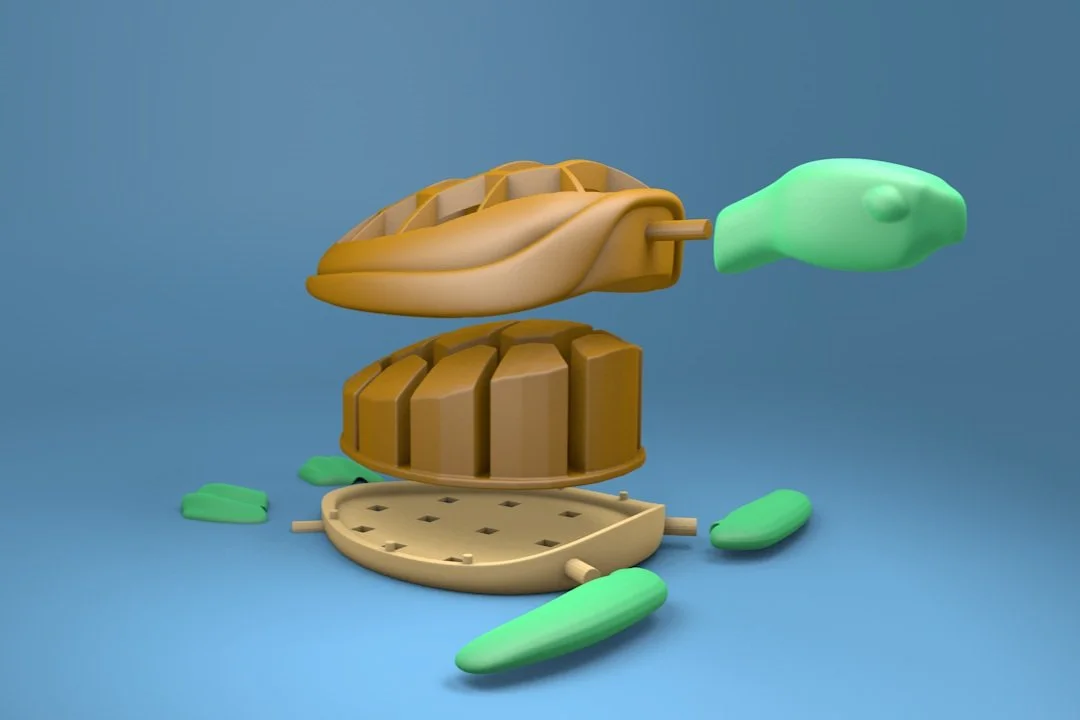
Stim Swim
Jellyfish Automata
While Stim Garden’s most complex component was the AR garden scene, I wanted to explore more complex versions of physical stim toys for the Stim Swim stim kit. After deciding upon an ocean-themed kit, I identified an opportunity to build upon the raindrop automata, re-imagining the rippling rings as the undulating bell of a jellyfish. While these invertebrates may appear to move through the water using their tentacles, their movement is powered by suction generated by the undulation of the bell, which in turn moves the tentacles, giving the appearance of using these appendages for movement. This slow rippling, repeating motion is the theme of much visual stimming content. I began re-designing the raindrop automata by adjusting the length of the cam followers so that the rings formed the shape of a jellyfish bell.
In order to give the illusion of the jellyfish floating through the water, a new base would need to be designed; while enclosing the moving mechanisms worked for the raindrop automata, the added bulk of a base that fully encased the toy would detract from the illusion of floating or swimming. While the first iteration of the new base (top) was structurally effective, it still seemed somewhat bulky and did not provide anywhere to attach tentacles, which are an important visual component of jellyfish swimming.
I experimented with many materials for the jellyfish tentacles, including rubber tubing, elastic jewelry thread, and even making and casting silicone molds. The rubber tubing, despite being only 1mm thick, was too inflexible to bend and move smoothly with the motion of the rings. Elastic jewelry thread was too thin to be easily visible and was prone to fraying. The size of the tentacles was so small that silicone casting became difficult and often resulted in torn castings. Eventually, the solution came from analyzing fidget toys for the precedent review: fidget pasta, a thin, stretchy silicone fidget toy. The strands of silicone were thick enough to be mounted on a modified version of the jellyfish automata base (bottom), and the silicone stretched and moved seamlessly with the automata rings.
With the tentacle issue resolved, it was easy to settle on a final base model. A series of pegs lines the outermost ring and middle support structure for the tentacles to attach to. While this design resolved the tentacle issue, it is even bulkier than the preliminary base design. In order to better create the sense that the jellyfish is floating or swimming, I 3D printed the base and middle support structure and made molds. that were then cast with clear resin, while the cam followers were 3D printed with clear PLA filament. I felt that the case covering the cams in the raindrop automata missed an opportunity for secondary visual stimming, so the cams were 3D printed with the same transparent blue filament used to print the rings. The jellyfish automata was then assembled and the tentacles were attached to the pegs by piercing holes in the end and middle of each piece of fidget ramen. I made the attachment more secure by using a specialty adhesive specifically for adhering silicone to plastics.
Sea Turtle Clicker Toy
I found it fitting to reference the sea turtle’s natural anatomy to inform the method of play. The sea turtle’s scutes (the segments that make up the top of a turtle’s shell) serve as a sort of natural division that makes the shell resemble a series of buttons, and the author decided to lean into this. The series of buttons was 3D printed in a single connected sheet using thermoplastic polyurethane (TPU). This material provides give and flexibility when depressed while retaining its shape better than silicone would. The buttons are aligned with the same tactile switches used in the frog pond toy to add an auditory dimension to play.
3D model of prototype
Reflective of the sea turtle’s hard shell, the top and bottom shells were 3D printed using PLA. As a second mode of play that references the sea turtle’s physiology, I 3D printed the model’s head and flippers, made silicone molds of these pieces, and cast them with silicone. The differing sizes and thicknesses of these pieces allows for different levels of tactile stimulation: the back flippers are short and thick, while the front flippers being longer and thinner causes them to flop around when the toy is picked up and played with. The head is thick and long, and while it doesn’t move as independently as the front flippers, users can make this piece move by flicking or pushing it.
Exploded view of prototype
Jellyfish Animation
While the primary focus of the Stim Swim stim kit was the physical toys with a higher level of detail and complexity than previous physical toys, I felt it necessary to also provide a virtual component for this kit for the sake of consistency. In order to not draw attention from the toys, I chose to make this virtual component a 3D animated stim video.
In comparison to the sea turtle clicker toy, the jellyfish automata’s design was more abstract in form; the focus was more on replicating the motion of the jellyfish than replicating its appearance. In order to create a visual cue to help audiences make the connection to jellyfish, I chose to animate jellyfish swimming through the water for this video. Ocean imagery is a popular theme in stimming content, and within that theme, jellyfish are a common subject. Their repetitive, undulating motions provide visual stimming, as established with the jellyfish automata toy.
I began by observing jellyfish swimming compilation videos and created a storyboard animation based on their basic steps in movement.
















